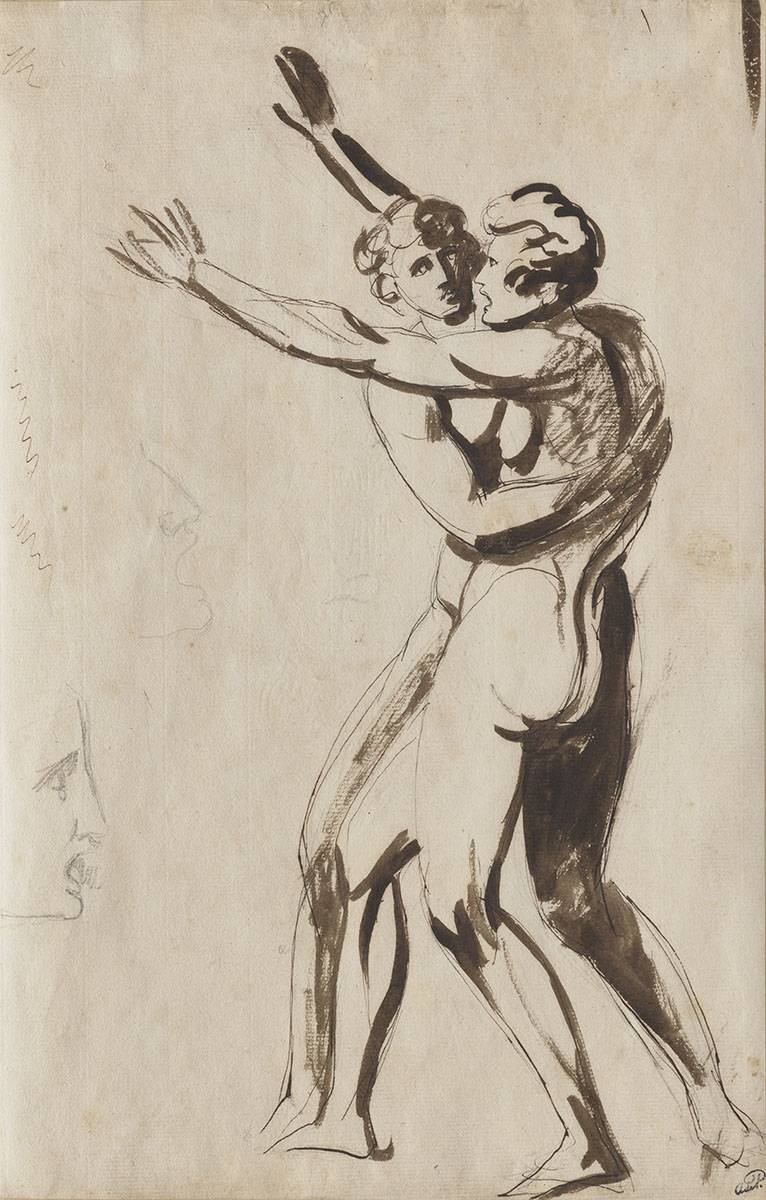This bold wash drawing of two figures almost certainly relates to George Romney’s restless interest in a design he had conceived for one of the so-called Liverpool Cartoons, the large-scale black chalk compositions which Romney was working on in the years after his trip to Rome. As was typical in Romney’s career, he revisited the poses of the key figures in the design, playing with elements of the composition as he arrived at the best illustration of the text. Romney’s decision to treat this subject was partly inspired by a commission from Edward Thurlow, the Lord Chancellor, to paint in 1780 the final parting of Orpheus and Eurydice as described in Book IV of Virgil’s Georgics.[1]
Despite the distinguished nature of the patron, Romney never completed the oil painting. William Hayley, Romney’s earliest biographer, attributed this failure to the fact that: ‘the ideas of the peer, and those of the painter were so different concerning the mode of treating it on canvas, that Romney despaired of pleasing a patron whose fancy appeared to him very far from being in harmony with his own.’[2] The diverging view of Romney and Thurlow may account, in part, for this grand figure study. Romney was evidently experimenting with how best to capture the physical and psychological action of the text.
Drawn with remarkable fluency in black chalk and then worked up in pen and ink, finely articulated with the brush in both liquid strokes of black ink and dryer passages, this large-scale figure study was almost certainly developed from one of Romney’s Liverpool Cartoons. Writing in his contribution to William Hayley’s biography, John Flaxman noted that Romney’s ‘cartoons… were examples of the sublime and the terrible, at the time perfectly new in English art… As Romney was gifted with peculiar powers for historical and ideal painting, so his heart and soul were engaged in the pursuit of it, whenever he could extricate himself form the importance business of portrait painting. It was his delight by day and study by night.’[3]
This complex sheet conveys something of Romney’s restless nocturnal study. The passage selected – and translated by – Lord Thurlow was later published by Romney’s son:
‘Such were the terms imposed by Prosepine –When
a sudden oversight surprised the unthinking
lover: he stopp’d – and – Eurydice just upon the
verge of light – forgetting – overcome with fond-
ness – he looked back – There all his labour was
lost, and the laws broken of a power deaf to mercy.
Thrice the lakes of Avernus heard the crash of
thunder. She cries, what hath undone the wretched
wife, and thee, Orpheus? What excess of phrenzy?
Lo the cruel Fates recall me, drowsiness loads my
Swimming eyes; and now farewell’[4]
In a shift of emphasis from the two large-scale cartoons, this study seems to focus on the dramatic moment ‘she cries, what hath undone the wretched wife, and thee, Orpheus?’ Romney has emphasised the moment Eurydice cries out, showing her in profile, mouth open; adding two profile studies in black chalk on the left-hand margin. Orpheus is shown restraining his wife as she is dragged back to the Underworld by the Furies, his face etched with disbelief at the consequences of his actions. It was Orpheus, not trusting that Eurydice was following him out of the Underworld, who looked back and thereby forfeited her life. The dynamism of the action is heightened by Romney’s sophisticated layering of media, the initial black chalk under-drawing emphasised with rapid pen and ink lines is then animated with liquid black wash, applied with the brush. The emphasis on the psychological drama of the moment confirms Flaxman’s observation that Romney was the master of ‘the sublime and terrible’.

George Romney
Orpheus and Eurydice
Black chalk
49 ⅝ x 39 5/8 inches; 1263 x 1008 mm
1775–1785
Presented to the Walker Art Gallery by the Liverpool Royal Institution in 1948
National Museums Liverpool
References
- Alex Kidson, George Romney A Complete Catalogue of hIs Paintings, New Haven and London, 2015, vol.III, cat. 1789, p.824.
- William Hayley, The Life of George Romney Esq., London, 1809, p.94.
- William Hayley, The Life of George Romney Esq., London, 1809, p.309.
- Quoted in Alex Kidson, George Romney: 1734-1809, exh. cat. London (National Portrait Gallery), 2002, p.135.


